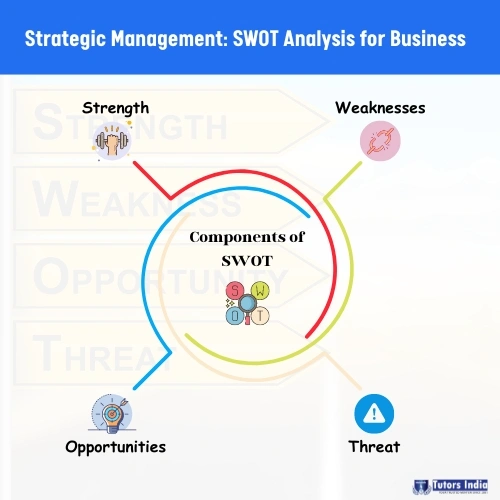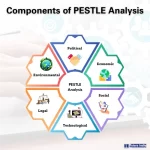SWOT Analysis for Strategic Management of Businesses
Introduction
A SWOT (Strengths, Weaknesses, Opportunities and Threats) analysis is a tool that facilitates organizational managers to evaluate the strengths, weaknesses, opportunities and threats that might exist in any kind of business. Conducting a SWOT analysis could prove to be very instrumental in helping the organization to acquire in-depth insights into the past and conjure potential solutions to current or potential challenges. This SWOT analysis can be carried out for an organization that is already existing within the market or for an organization that intends to make an entry into the market in the near future (Gurl, 2017).

SWOT and PESTLE analysis are among the most common tools for strategic management. In particular, SWOT comes across as a model that is very fundamental and transparent that can evaluate what a business can do or incapable of doing, along with the possible opportunities and threats. The SWOT analysis technique is to consider the information generated through an environmental evaluation and segregate it to internal (strengths and weaknesses) and external issues (opportunities and threats). Following the completion of this activity, the SWOT analysis would determine what would aid the organization in realizing their objectives, and the kind of challenges that need to be overcome or reduced to realize the intended outcomes (Namugenyi et al., 2019). Many organizations execute a SWOT analysis during the stage of their strategic planning and they attempt to identify and scrutinize the prevalent resources, both externally as well as internally, examining their patterns and trends that might result in either positive or negative business outcomes. Some examples of SWOT analysis that have been conducted include SWOT analysis for retail store, SWOT analysis for Amazon, SWOT analysis for Tesco, SWOT analysis for British Airways, SWOT analysis for Morrisons and SWOT analysis for Asda.
The objective of this paper is to familiarize you with the components of SWOT and tips to conduct a SWOT analysis.

Components of SWOT .
The actual process of SWOT analysis would comprise of splitting four areas into two dimensions. The four components of SWOT as mentioned above is Strength, Weakness, Opportunities and Threats. Strengths and weaknesses can be deemed as factors that are internal and make up the organizational attributes while, opportunities and threats would be factors that are external and are usually the environmental attributes (Gurl, 2017).
Strengths
This, as you would know makes up the first component of the SWOT. This component would consider aspects of your organization that is doing particularly well. It need not be anything tangible or definite. The strength of your organization could also be intangible such as the brand image of an organization or something which can be very easily defined such as the organization’s unique selling proposition (USP) of a specific line of products (Brooks, 2014). In other cases, it could also be the human resources of the organization; robust leadership or a highly effective research and development team. Thus you identify the strength of your organization.
Weaknesses
Following the identification of the organization’s strengths, the next step would be to be critical about oneself and identify and list out anything that you think would be the weakness of your organization. Weakness does not refer to physical weakness here but rather it refers to aspects of the organization that is pulling your organization back. Weaknesses could be anything such as financial constraints, lack of skilled personnel, superior brand image of competitor etc. Akin to strengths, weaknesses also are an innate aspect of your organization. Therefore, it would help if you focus on resources, procedures, systems and people. Consider aspects that needs improvement and the kind of practices that you need to curb (Wang et al., 2014).
Opportunities
Opportunities would refer to chances of something good or positive happening. However, it would not happen on its own, you need to identify the opportunity and seize it. Opportunities would generally tend to emerge from situations that exist beyond your organization, and it requires foresight on your part as to what might happen in future. Market or technology developments can be one (Brad & Brad, 2015). For instance, in case there is a surge in demand for a niche product that your organization can produce, that is an opportunity you can leverage. But as mentioned, you need to be able to identify opportunities and harness it such that it makes a difference to your organization.
Threats
Lastly, the component of threat would comprise of anything that has the propensity to make a negative impact on your business externally. These would include; problems within the supply-chain, manpower shortage or changes in market demands etc. It is very necessary that you anticipate threats and initiate appropriate action to negate the threat before it impacts you and causes a loss to your business or thwarts your growth (Sarbah & Otu-Nyarko, 2014). To identify threats, it might help if you try to list out the bottlenecks to your business such as delivering your finished goods to the market, drop in quality of your products amongst others. Further, you should always keep yourself abreast of the activities that are being carried out by your competitors and modify your strategy to tackle that threat. Also there is the threat of new governmental or trade policies so, you need to anticipate such threats to stay ahead of the competition and ensure success.
Conclusion
SWOT analysis is a tool that is being utilized within the domain of strategic management for the past five decades. It has turned out to be a highly treasured tool as far as planning and decision-making is concerned. While there are a number of tools for analysis that have been utilized during the strategic management process, over the years a technique that has been extensively used is SWOT analysis. The use of SWOT helps in evaluating the external as well as the internal environment of the organization and thereby lends support to situations where strategic decisions are required. This technique can be applied in several areas that require strategic analysis for an industry, a product, an organization, a city, a project or even an individual.
About Tutors India
We are a team of researchers and academic writers who offer dissertation and coursework assistance. We provide essay and assignment writing help for Master’s students. Our diverse team enables us to help students from multiple disciplines to seek academic guidance. We help students write assignments, essays, literature reviews and dissertations per the university recommendations. Wel also help business students formulate business plans, which are integral to their dissertations. We ensure they are grammatically correct without plagiarism and are cited and referenced correctly, guaranteeing the students are satisfied with our services.
To know how a business plan is written, check out our business plan example.
References
- Gurl, E. (2017). SWOT analysis: A theoretical review. http://dx.doi.org/10.17719/jisr.2017.1832
- Namugenyi, C., Nimmagadda, S. L., & Reiners, T. (2019). Design of a SWOT Analysis Model and its Evaluation in Diverse Digital Business Ecosystem Contexts. Procedia Computer Science, 159, 1145–1154. https://doi.org/10.1016/j.procs.2019.09.283
- Brooks, G., Heffner, A., & Henderson, D. (2014). A SWOT Analysis Of Competitive Knowledge From Social Media For A Small Start-Up Business. Review of Business Information Systems (RBIS), 18(1), 23–34.
- Wang, Xuping & Zhang, Jun & Yang, T.. (2014). Hybrid SWOT Approach for Strategic Planning and Formulation in China Worldwide Express Mail Service. Journal of Applied Research and Technology. 12. 230-238.
- Brad, S. & Brad, E. (2015). Enhancing SWOT Analysis with TRIZ-based Tools to Integrate Systematic Innovation in Early Task Design. Procedia Engineering. [Online]. 131. pp. 616–625. https://doi.org/1016/j.proeng.2015.12.455
- Sarbah, A. and Otu-Nyarko, D. (2014) An Overview of the Design School of Strategic Management (Strategy Formulation as a Process of Conception). Open Journal of Business and Management, 2, 231-249. .

 Previous Post
Previous Post Next Post
Next Post